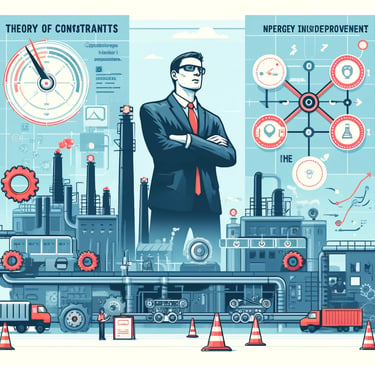"The Goal" by Eliyahu Goldratt
Discover the transformative power of Eliyahu Goldratt's "The Goal." Learn how the Theory of Constraints can enhance productivity and drive continuous improvement.
BOOKS
The Procure 4 Marketing Team
6/27/20244 min read


Eliyahu M. Goldratt's "The Goal: A Process of Ongoing Improvement" is a seminal work in the field of operations management, offering profound insights into the Theory of Constraints (TOC) and its application in improving business processes. Written as a novel, the book follows the story of Alex Rogo, a plant manager, as he struggles to turn around his failing factory. For procurement, supply chain, and marketing professionals, Goldratt's principles provide a powerful framework for optimizing processes, enhancing efficiency, and achieving strategic objectives. This review explores key themes, critical analysis, and practical applications of Goldratt’s ideas for these fields.
Overview
"The Goal" is more than just a business book; it's a narrative that humanizes the challenges faced in manufacturing and operations management. Through Alex Rogo’s journey, Goldratt introduces the Theory of Constraints, a methodology for identifying and addressing the most critical limiting factor (constraint) in a process, thereby driving significant improvements in performance. The book’s blend of storytelling and theoretical insights makes it accessible and engaging, providing valuable lessons for professionals across various industries.
Key Themes
Theory of Constraints (TOC): At the heart of "The Goal" is the Theory of Constraints, which posits that every system has at least one constraint that limits its performance. Goldratt emphasizes the importance of identifying this constraint and systematically improving it to enhance overall efficiency. This theme is particularly relevant for procurement and supply chain professionals who must continually optimize processes to meet demand and reduce costs.
Continuous Improvement: Goldratt advocates for a culture of continuous improvement, where organizations constantly seek ways to enhance their operations. This involves not just addressing constraints but also regularly reviewing and refining processes. For marketing professionals, this theme underscores the importance of agility and responsiveness to market changes.
Holistic Thinking: "The Goal" highlights the interconnectedness of different functions within an organization. Goldratt argues that optimizing individual parts of a system without considering the whole can lead to suboptimal results. This holistic approach is crucial for supply chain managers who need to ensure seamless integration across various stages of the supply chain.
Effective Measurement: Goldratt emphasizes the need for effective measurement and metrics that align with organizational goals. He criticizes traditional metrics that focus on local efficiencies rather than overall performance. This insight is valuable for procurement professionals who must develop KPIs that reflect true value creation and cost savings.
Change Management: The book addresses the challenges of implementing change, highlighting the resistance and inertia often encountered. Goldratt provides strategies for overcoming these barriers, making it relevant for all professionals involved in driving transformation within their organizations.
Critical Analysis
While "The Goal" is widely acclaimed, it is not without its criticisms and limitations.
Simplistic Narrative: The novel format, while engaging, sometimes oversimplifies complex issues. The solutions presented may appear straightforward in the narrative but can be more challenging to implement in real-world scenarios. Professionals should be cautious not to underestimate the complexity of their specific contexts.
Manufacturing Focus: The book’s primary focus is on manufacturing operations, which might limit its direct applicability to other industries. However, the underlying principles of TOC and continuous improvement are universally relevant and can be adapted to various fields, including services and technology.
Implementation Challenges: Applying the Theory of Constraints requires significant changes in mindset and organizational culture. The book does not delve deeply into the practical challenges of implementing TOC in large, complex organizations. Professionals must be prepared for potential resistance and the need for sustained effort to achieve results.
Implications for Procurement, Supply Chain, and Marketing Professionals
Procurement: For procurement professionals, "The Goal" offers valuable insights into optimizing the procurement process. By identifying and addressing constraints in the supply chain, procurement managers can enhance efficiency, reduce lead times, and negotiate better terms with suppliers. The emphasis on effective measurement also helps in developing more meaningful KPIs that drive strategic objectives.
Supply Chain: Supply chain managers can leverage the Theory of Constraints to improve overall supply chain performance. By focusing on the most critical bottlenecks, managers can streamline operations, reduce inventory levels, and enhance throughput. The book’s holistic approach encourages collaboration across different functions, ensuring that improvements in one area do not negatively impact others.
Marketing: Marketing professionals can apply Goldratt’s principles to develop more agile and responsive marketing strategies. The concept of continuous improvement is particularly relevant in today’s fast-paced market environment, where consumer preferences and competitive dynamics are constantly evolving. By adopting a holistic view, marketers can ensure that their strategies align with overall business objectives and drive sustainable growth.
Conclusion
"The Goal: A Process of Ongoing Improvement" by Eliyahu M. Goldratt is a must-read for procurement, supply chain, and marketing professionals seeking to enhance their operational efficiency and drive continuous improvement. The book’s blend of narrative storytelling and theoretical insights makes complex concepts accessible and engaging, providing practical lessons that can be applied across various industries.
Goldratt’s Theory of Constraints offers a powerful framework for identifying and addressing bottlenecks, ensuring that improvements lead to significant and sustainable performance gains. By fostering a culture of continuous improvement, professionals can drive transformation within their organizations and achieve strategic objectives.
While the book’s manufacturing focus and simplified narrative may limit its direct applicability in some contexts, the underlying principles are universally relevant and can be adapted to different fields. Professionals should be prepared to navigate the challenges of implementation and customize the concepts to fit their specific needs.
In conclusion, "The Goal" is an invaluable resource that provides a fresh perspective on operations management and continuous improvement. By embracing the principles outlined in the book, procurement, supply chain, and marketing professionals can enhance their strategic decision-making, optimize processes, and contribute to the overall success of their organizations.

